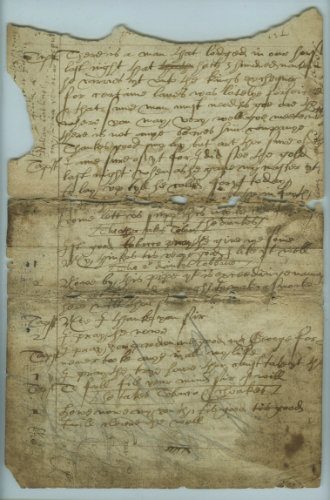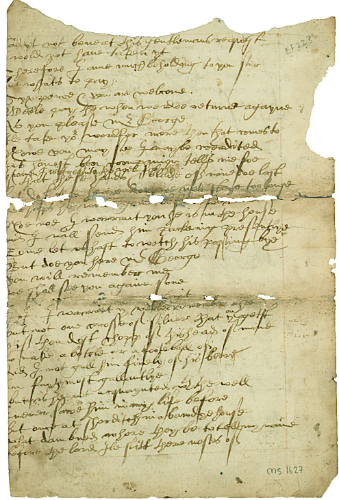Play of Thieves and a Gullible Tapster
Anon. (c.1605?)
NB. "Play of Thieves and a Gullible Tapster" is a recent assignation (from Wiggins 1470) for this untitled play. The name is used here for convenience.
Historical Records
Schøyen MS 1627
A fragment preserved in the binding of a copy of the 1586 Geneva edition of Homer's Odyssey was found by Patrick King in 1988. It is now MS 1627 in the Schøyen Collection in Oslo:

|

|
| Schøyen MS 1627, recto © The Schøyen Collection, Oslo and London |
Schøyen MS 1627, verso © The Schøyen Collection, Oslo and London |
Transcription
The following transcription is derived from Freeman's in conjunction with fresh readings of the digitised fragment above.
[recto] Tapst There is a man that lodged in our house last night that thathhath 3 hundred markes in [ ]he carries yt vnto the kings exchequer for certaine lands was latelye forfeited & that same man must needes go ore the [ ] where you may very well goe meete wth [ ] there is not anye beares him companye 2 Thankes good my boy but art thou sure of th[ ] Tapst I ame sure of yt for I did see the gold last night when as he gaue my master yt to lay vp tyll he calld for yt today 2 [ ] of the in fayth comm lett us supp this licour [ ] he drinkes The other takes Tobac Ist good tobacco pray the guie me some 1 My thinkes tis verye good I like yt well The 2d drinkes Tobbacco 2 Now by this pipe yt is exceedinge maing[ ] but yet tis good enough to make a smoake here wilt thou some Tobacco Tapst Noe I thanke you sir 2 I praye the nowe Tapst I pray you pardon me good mr George for [I] neuer tooke anye in all my life 1 I pray the trye howe thou canst take yt th[ ] Tapst To full fill your mind sir I will he takes Tobacco & choakes 2 Howe nowe my youth, tis good tis good twill cleare the well [verso] [Tapst] [H]ad yt not bene at this gentlemans request [I] wold not have taken yt Therefore I ame much beholding to you sir [2] [B]ut whats to pay. [Tapst] Syx pence & you are welcome. [2] Weele pay the when we doe returne agayne [Tapst] As you please Mr George [2] Now you may see I maybe creadited This honest boon companion tells me soe [By] heaven I will requite the well for that [I]f that these hands & blade of mine do last [but] dost thou heare doe we not staye too longe perhapps he w[ill be] gon [be]fore [ ] [Tapst] Noe noe I warrant you he is in the house [A]nd I will send him packeing presentlye [2] Come let vs hast to watch his passing bye [Tapst] But doe you here mr George you will remember me [2] We shall see you againe sone Exit I I, I warrant ye weele remember the but not one crosse of siluer that you getst [ ] if thou dost chopp of this head of mine to make a bottle or a footeball of [D]id I not gull him finely of his beere [1] [I]n fayth most gallantlye but is he not acquaynted wth the well [2] I never sawe him in my life before but once at shorditch in a bawdye house what dambned whore they be to tell my name before the lord Ile slitt there noses of
Theatrical Provenance
Unknown.
Probable Genre(s)
History? (see Possible Narrative and Dramatic Sources or Analogues below)
Possible Narrative and Dramatic Sources or Analogues
The 'Tapster fragment' imitates the tavern scenes from Shakespeare's 1 Henry IV: it features a tapster speaking to two thieves (one named George) about a man carrying 300 marks to the king's exchequer, in direct imitation of the Gadshill robbery in Shakespeare's play.
References to the Play
Information welcome.
Critical Commentary
Freeman published the transcription along with detailed commentary in 1998. Speaking of the Geneva edition of Homer in whose binding the fragment was found, he notes that "The binding itself is English, almost certainly from an Oxford workshop, smooth calf with triple blind fillets on the covers, with four cords -- let into the boards horizontally, in parallel -- and two ornamental bands on the spine above and beneath them, exhibiting characteristic Oxford hatch-marks in blind on the lower edge. The style is too clearly generic to suggest a date-range narrower that [sic, than] 1586 (publication) through about 1620" (99). He further adds:
The hand of the manuscript is a good fluent full secretary, with several distinguishing characteristics: a full loop sometimes extending well under the letters for initial 'm', 'v' and 'w', and a flamboyant majuscule 'N' and 'M'. I have compared it with a large number of English literary hands of the period, including (I think) every named professional dramatist whose penmanship survives, and nearly all playhouse scripts -- many in multiple hands -- without finding a credible match. The page-size is unusually small for a play: it is cut down from a leaf which would correspond to 'small quarto' in a printed book, with horizontal chainlines and half a 'pot' watermark at the inner edge, lined in red...(99)
See also Wiggins 1470, who assigns a general date range of 1600-1620 and for Catalogue purposes places the play within c.1605.
For What It's Worth
Attempting to decipher the marginal scribblings on the manuscript, Freeman reads "...or fiddle / fiddle & / Italian Catlins / mysteria verbi. ad popul[um?]", and suggests "these notes may relate to a musician's inventory or wants-list -- appropriate, perhaps, to a playhouse or to amateur or university theatricals" (100).
It is also curious, as Freeman notes, that the "text is a little unusual in having no normal dividers -- that is, short horizontal lines, between speeches -- and yet having stage-directions boxed. Richard Proudfoot had pointed out to me that the same characteristics obtain in the manuscript of Tom a Lincoln, a Gray's Inn play of c.1611, perhaps by Thomas Heywood. Certainly the manuscript is a transcript of a prior text -- the deliberately inserted line 37 shows this to be true -- and both because of the small format and the self-contained matter of the scene it is tempting, if undemonstratable, to imagine it as an actor's 'side', or part, copied out for memorization" (100).
Works Cited
Site created and maintained by David McInnis, University of Melbourne; updated 20 May 2016.